#giant Brazilian blonde tarantula
Text


hello from Vault Tec!
#she still looks so scraggly looking#hurry up and molt so you look less nasty#Vault Tec#the tarantulas#spider#tarantula#giant Brazilian blonde tarantula#Nhandu tripepii
31 notes
·
View notes
Text
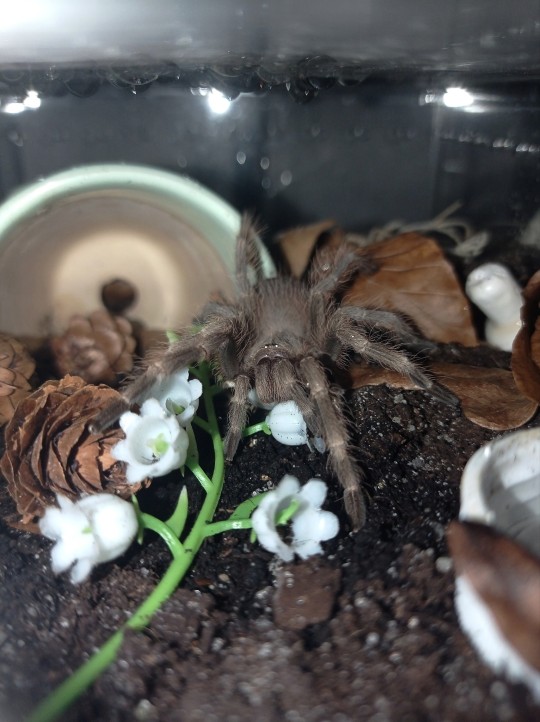
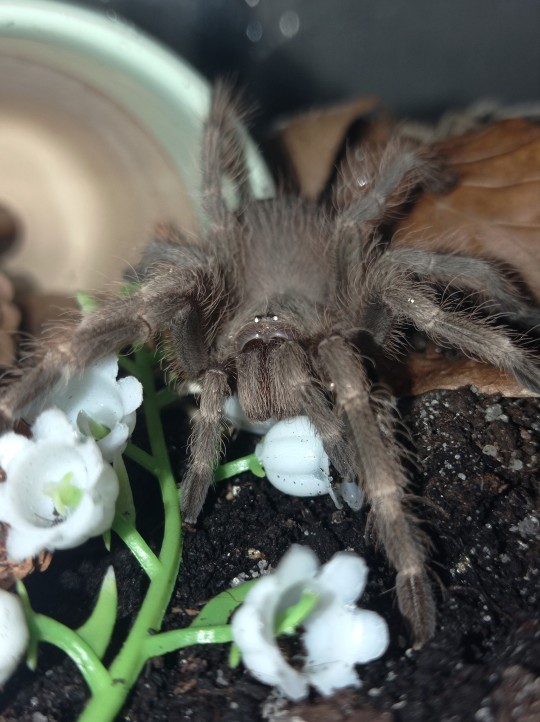
She's plotting war crimes btw <3
#she is very cute and so very nasty mannered#bugs#arachnids#spider#tw spiders#tarantula#sling#pet tarantula#nhandu tripepii#brazilian giant blonde
7 notes
·
View notes
Text
So, I have new spiders!
I bought a sub-adult Avicularia Avicularia from the spider shop along with their 10 sling lucky dip
1) Aphonopelma Anax - Texas Tan (I lost my aphonopelma hentzi recently, and while I'd still like to try again, this is a nice substitute)
2) Aphonopelma Seemani - Stripe Knee (my first one, surprisingly. I've loved the look on them, but I've been holding off for some reason, well, until now)
3) Holothele Longipes - Dwarf Pink/Colombian Blue Leg (this will be my second one)
4) Kochiana Brunnipes - Pink Leg (another duplicate in my collection)
5) Lasiodoa Parahybana - Salmon Pink Bird Eater (I wasn't going to get this because they can get up to 10", but this tiny sling has a lot of growing to do until then)
6) Nhandu Tripepii - Brazilian Blond (I lost my original one of these little guys and was really upset, so I'm happy to have another)
7) Pseudoclamoris Gigas - Orange Tree Spider (my notes in my tarantula spreadsheet for this guy read 'fast, so fast, too fast' which is why I never got one... guess I'm going to have to keep a careful eye when I feed them)
8) Pterniopelma Sazimai - Iridescent Blue/Sazimai's Tarantula (one that I was keeping until I got a little more experience under my belt, but had been considering lately - I love blue spiders)
9) Tliltocatl Vagans - Mexican Red Rump (score, I've been waiting to get one of these for a while, just wasn't sure if I'd get a juvie or a sling)
10) an 'Angustum' type, the vial says 'S', which would be a 'Sericopelma', but this is more likely to be Tliltocatl Angustum, another duplicate but one I don't mind
Not bad! And some of them I wouldn't have chosen on my own, so that's cool.I did ask for no OW species, I’m definitely not there yet.
In other bug news, I'm looking at some praying mantids: Hierodula membranacea - Giant Asian Mantis, phyllocrania paradoxa - ghost mantis, and my most wanted, a miomantis paykullii - the egyptian praying mantis. I'd love a straw coloured one, but I'm not that fussy. The only thing is they're really hard to find here, especially at the moment.
I spent too long considering the Fufius sp 'Rurrenabaque', or Gold Wafer-Lid Trapdoor Spider and now they're sold out, so I'm going to have to wait for them to come around again.
I also want to get a jumping spider, ideally Phidippus Regius Isla Juventus.
I'm mostly holding off on all of the above because I'm going to need to handle flightless fruit flies for the first time and I'm not in a place to deal with a new learning curve at the moment - heatwaves plus a change of migraine treatment and an overwhelming constant giddiness is making everything hard.
I'll get there eventually, especially when I get my dart frogs set up, and I think they'll be helpful for supplementing sling diets, but until then...
I'm also considering getting into beetles. I'm interested in flower beetles and rainbow staghorns, and I'm also casting an eye over therea olegrandjeani, the question mark cockroach.
2 notes
·
View notes
Video
Nhandu tripepii | Brazilian Giant Blonde (unsexed juvenile, 2.5″)
See more photos of this species here!
37 notes
·
View notes
Photo
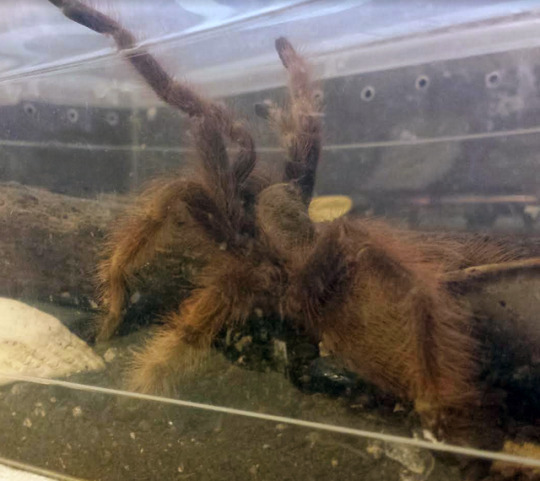
Thor’s never throw a threat display at me before (I am so disappointed in you young man). I WAS JUST TRYING TO CLEAN YOUR WATER.
47 notes
·
View notes
Note
What are all the types of pets you have and how many do you have of each? What are their names? 💜
aahh ok this is my favourite ask
Cats 🐈:
Ellie, 7 year old seal point siamese
Zoe, 4 year old blue point siamese
Melly, a black cat, we rescued her as an adult so we think she’s ~5 but 🤷♀️
Reptiles🦎:
Mochi - a 2 year old ‘tangerine tornado’ leopard gecko
Kiwi - a 6 month old ‘extreme halloween harlequin’ crested gecko
Inverts🕷🦂:
Antilles pinktoe tarantula (Caribena versicolor) named Bilbo
Pinktoe tarantula (Avicularia avicularia) named Boots
Brazilian black tarantula (Grammostola pulchra) named Arwen
Brazilian blonde tarantula (Nhandu tripepii) named Peaches
Mexican fireleg tarantula (Brachypelma boehmei) named Ember
Mexican red knee tarantula (Brachypelma smithi) named Eowyn
2x Curly haired tarantulas (Tlitocatl albopilosum) named Vex'ahlia and Vax'ildan
Mexican pink tarantula (Brachypelma Klaasi) named Azalea
Asian forest scorpion (Heterometrus spinifer) named Scorpo
Titan isopods (Porcellio hoffmannseggi)
Dairy cow isopods (Porcellio laevis)
Zebra isopods (Armadillidium maculatum)
Powder blue isopods (Porcellionides pruinosus)
I’m also waiting on an order of mantids, the breeder’s waiting for them all to get to their third molt before shipping, so in the next week I’ll be receiving 2 orchid mantids, a giant dead leaf mantis, a ghost mantis, a bordered mantis, an australian rainforest mantis, and a regal jumping spider 🙃
#that list of inverts is getting long lmao#and oh man i'm planning on ordering 3-4 more tarantulas tomorrow as a birthday present to myself lmao#spiderblr#tarantula#bugblr#inverts#Anonymous
2 notes
·
View notes
Text
LIST OF SPIDERS AND ALSO OTHER ARACHNIDS
For those who were curious, I have been working on getting an exhaustive list of Tarantulas and other arachnids I currently am keeping. Scientific names are italicized, while “common” names are in bold. And, of course, for those who have names, those are in quotations.
TARANTULAS:
1.2 Pterinochilus murinus Orange Baboon (Usambara Orange Morph) “Marigold” -REVENANT TARANTULA, “Cosmo”, and unnamed male
0.1 Gramnostola pulchra Brazilian Black “Dahlia”
0.1 Tliltocatl albopilosum Curlyhair
0.2 Tliltocatl vagans Mexican Redrump
0.0.1 Heteroscodra Maculata Togo Starburst Baboon “A-mini-tefe”
2.1 Poecilotheria metallica Gooty Sapphire
1.0 Pelinobius muticus King Baboon “Daisy”
1.0 Psalmopoeus irminia Venezuelan Suntiger
0.1 Avicularia avicularia Common Pinktoe “Rose”
1.0 Poecilotheria subfusca Ivory Ornamental Tarantula (Lowland morph) “Narcissus”
1.1 Chilobrachys sp vietnam blue Asian Blue Smokey
0.1 Aphonopelma chalcodes Arizona Blonde “Buttercup”
1.1 Chromatopelma cyaneopubescens Greenbottle Blue
1.0.1 Theraphosa blondi Goliath Birdeater “Hibiscus” and unnamed unknown gender
2.0 Pamphobeteus antinous Bolivian Blueleg Birdeater
0.0.1 Chilobrachys sp. kaeng krachan Dark Earth Tiger “Kraang” (I did not name this one)
0.1 Stromatopelma calceatum Featherleg Baboon
0.1.1 Theraphosinae sp. panama Panama Pink
NON TARANTULA SPECIES:
0.0.1 Mastigoproctus giganteus Giant Vinegaroon “Fang” (I did not name this one)
0.1 Paragaleodes sp. “Fuzzy Solifugid” “Fuzzy” Camel Spider
0.1 Latrodectus variolus? Northern Black Widow “Mandy”
((ooc note: please for the love of god do not look these up if you are arachnophobic at all, especially the two non-spiders on this list))
2 notes
·
View notes
Text
Tarantula Wishlist
no pics, just me taking notes
GBB/Chromatopelma cyaneopubescens
Nhandu tripepii/Brazilian Giant Blonde
Psalmopoeus cambridgei/Trinidad Chevron
Caribena versicolor/Antilles pinktoe tarantula
2 notes
·
View notes
Text
Animal Wish List: Columbian Dwarf Boa Dumeril's Boa Green Tree Python Mandarin Rat Snake Spotted Python Rainbow Boa Eastern Hognose Snake Satanic Leaf Gecko Giant Caledonian Gecko Frilled Dragon Thorny Devil Madagascar Day Gecko Brazilian Black Tarantula Honduran Curlyhair Tarantula Arizona Blonde Tarantula Pinktoe Tarantula Trapdoor Spider Asian Forest Scorpion Emperor Scorpion Desert Hairy Scorpion Whiptail Scorpion Rhinoceros Beetle Elephant Beetle I want to care for these animals at least once in my life.
5 notes
·
View notes
Text
12 Differences Between Spiders And Tarantulas
To some, the differences and similarities between spiders and tarantulas are of little consequence. The only bit of information they cling to is the fear they feel when they see either. But as an avid tarantula lover and owner of four, I needed to know more.
So, what is the difference between a spider and a tarantula? All tarantulas are spiders, but not all spiders are tarantulas. Tarantulas are usually large, always covered in hairs, and they are hunters that pounce on their prey, unlike spiders that spin webs.
Being the largest spider in the world, the Goliath birdeater tarantula is the leader of the family and is only beaten for the record by the giant Huntsman spider due to its elongated legs.
If I imagine a fight between these two colossal spiders, my money would be on the Goliath birdeater as it has a weight advantage, weighing in at 170g.
Another fascinating defense mechanism tarantulas have is flicking the sharp hairs on their abdomen or legs at their enemy. Ouch! If you want to know more about the fascinating characteristics of tarantulas and true spiders, read on.
Seven Differences between True Spiders and Tarantulas
Before we have a look at the differences between spiders and tarantulas, let’s first see what they have in common.
Below is a list of the similarities between mygalomorphs – an infraorder of spiders to which tarantulas belong – and araneomorphae (true spiders).
Eight legs
Fangs
Venom glands (although not all)
Spinnerets
Silk spinning
Two body regions
Male palpi
1. Tarantulas are older
Tarantulas are old-timer arachnids and have been around longer than true spiders.
2. Size
Tarantulas are larger than most other spiders. The average leg span, measured from the front leg to the rear left leg, is between 4.5 to 11 inches. They can weigh anything from 28.3 to 85 grams.
3. Temperature needs
True spiders can tolerate colder temperatures than tarantulas, which prefer warmer climates. Since they contain a type of antifreeze in their bodies, true spiders can withstand temperatures of 41° Fahrenheit; they go dormant until the weather warms up again.
Debunking a Myth: Spiders do not go indoors when it gets cold; they are perfectly fine to stay outside all year round.
4. Their hair and what they use it for
Certain spiders will have hair, but tarantulas are always hairy. Some of these hairs, also called setae, have evolved to be used to defend themselves.
Termed urticating hairs, tarantulas kick these ‘barbed’ hairs off of their abdomen or legs, irritating the victim, and in some instances, even killing small animals.
True spiders don’t possess this defense mechanism, which is okay, they are petrifying enough without it for most people, don’t you agree?
youtube
5. Hunting style
Tarantulas don’t spin a web to catch their prey as true spiders do, but they do spin silk. Where other spiders have six spinnerets, tarantulas only have two, and one is barely visible.
But to make up for having less of these silk-exuding tubes, some tarantulas have silk-producing glands in their feet.
Tarantulas will use silk to line the walls of their burrows, spin a ‘door’ to the burrow to keep predators out or use it as a tripwire that will either alert them to unwanted visitors or that dinner has arrived.
Interesting fact: Web-building spiders have very poor eyesight.
6. Claws and grip
Tarantulas and true spiders have two claws at the tip of each leg – except in the case of Orb Weaver members, they have three and use one as a type of thumb.
Spiders use these claws to grip surfaces and to climb their web – but tarantulas have an advantage; they have densely hairy feet that give them extra grip, something they badly need considering their size.
If you look at a tarantula foot under an electron microscope, you will see a footpad with bristles covered in hundreds of thousands of small hairs called setules.
If that is not cool enough, to scale up slippery surfaces, tarantulas will retract their claws, just like a cat, and use only these hairy feet to ascent.
7. Their fangs are different
Tarantulas have strong jaws and fangs. Their fangs are parallel and face downward – think of Dracula – meaning they can only bite top down. When not in use, tarantulas tuck their fangs under their bodies.
True spiders, on the other hand, have fangs that face each other and will swing to the side and open up when they are ready to strike. A true spider’s fangs are much more flexible.
8. Lungs
Spiders only have one book lung; tarantulas have two lungs.
9. Some spiders are vegan?!
Tarantulas are meat-eaters through and through, but some spiders prefer a plant-based diet. Shocking, I know.
10. Venom and deadliness
While most true spiders are harmless, some do have deadly bites. There are 30 spiders of the non-tarantula variety that are deadly to humans. This includes the notorious Australia’s Funnel Web spider, Brazilian Wandering spider, Widow spider, and Brown Recluse spider.
Their venom is a cocktail of peptides, proteins, sugars, and other substances and maybe a neurotoxic or cytotoxic.
A spider bite(arachnidism) that is neurotoxic affects the nervous system of prey animals and humans; cytotoxin is used to liquefy their meals, but in humans, it may cause blisters and lesions.
Lucky for us, we’re not living in the old ages anymore, and antivenin and effective medical care has reduced the number of deaths from spider bites significantly.
Interesting fact: Neurotoxic venom kills quicker than cytotoxic venom. Black Widows and Redback Spiders are known for neurotoxic venom, and Recluse spiders have necrotizing cytotoxic venom.
Tarantulas are harmless when it comes to venom; the bite of a new world tarantula has been said to be similar to a bee sting. Old world tarantulas, however, do pack more punch, and their bites can involve swelling, pain, and even nausea.
Although there aren’t a lot of studies on the potency of tarantula venom, research is currently being done on its pharmaceutical use to treat pain and epilepsy.
Interesting fact: Mature male tarantulas may have more potent venom since they have to travel far and wide to find females and will inevitably face large predators along the way.
Of course, it doesn’t matter how mild a true spider or tarantula’s venom is, there is always the chance of an infection or allergic reaction, so best to avoid it altogether!
11. Eyes and vision
True spiders usually have eight eyes, some can have six or less, and others may be completely blind! Tarantulas always have eight eyes, and studies have shown that arboreal tarantulas have better vision than terrestrial or fossorial tarantulas.
However, what we know about their vision is limited to light, shadows, and motion.
Of all spiders, jumping spiders have remarkable vision and are said to be able to see the craters on the moon? Say what? How is that even possible?
Well, the two large eyes in the center of their forehead pick up details and color, and thanks to specific filters, these spiders can see more colors than we can.
The second pair of eyes perceive motion, and this indicates to the spider where it should look, and the function of the third pair is yet unknown!
Fun fact: Jumping spiders can chase a laser like cats.
12. The lifespan of Tarantulas vs The lifespan or True Spiders
If cared for properly, pet tarantulas will easily outlive your cat or dog. Female tarantulas have a longer lifespan, with some growing to be 30 years old. Sadly, most males only live for seven years.
Even though tarantulas have longer lives compared to true spiders, the oldest spider in the world was not a tarantula but a female Armored Trapdoor spider. She was 43 years old when she died in 2016. (Source)
This, however, was a particular case as spiders other than tarantulas aren’t usually kept as pets, leaving them to fend for themselves in nature and face predators of various sizes.
In general, the life expectancy of most true spiders is between two and three years, but some true spiders, like the Australian Funnel Web spider, for example, can live up to 25 years.
Females tend to live longer because they don’t have to travel around to find a mate, lessening their encounters with predators.
It’s a hard life if you’re a male spider; you search far and wide for your spidermate, face threatening situations, and after seeing your companion, there’s a high possibility you will get cannibalized. Shame man.
Best Tarantulas to Keep as Pets
With over more than 800 tarantula species, you’re spoilt for choice. But before you get yourself the most aggressive tarantula possible, for example, the ill-tempered Cobalt Blue, start with the more docile ground dwellers and burrowers mentioned below.
Mexican Red Knee
Chilean Rose
Costa Rican Zebra
Mexican Redleg
Honduran Curly Hair
Pink Zebra Beauty
Pink Toe
Brazilian Black
Mexican Red Rump
Desert Blonde
Best True Spiders to Keep as Pets
If you’re not a fan of owning a big hairy tarantula but still want a spider as a pet, you’re in for a journey of trial and error.
Although there are some basic care needs to keep spiders alive, there are subtle differences in the requirements that must be met to keep your spider happy and not just breathing.
And considering that owning spiders other than tarantulas are not common, there isn’t a lot of information on keeping such pets.
That being said, the two most common true spiders that are kept as pets are wolf spiders and jumping spiders.
Now, after reading just how remarkable jumping spiders are, I am keen to get one myself. But good grief, caring for such a small creature, must be even more nerve-wracking than looking after a Goliath birdeater.
What if Spinderella escapes from her tiniest of enclosures, I would be heartbroken!
When it comes to wolf spiders, you might be confused in thinking that this is a type of tarantula, and yes, some of the species do look a lot like tarantulas.
However, they’re from the araneomorphae infraorder, making them true spiders.
Wolf spiders are very unassuming; it will take a lot, and I mean really threatening a wolf spider for them to strike.
That makes them the ideal true spider pet, and since they are much bigger than the tiny jumping spider, you’ll have an easier time enjoying your pet, as you will actually be able to see it!
0 notes
Text
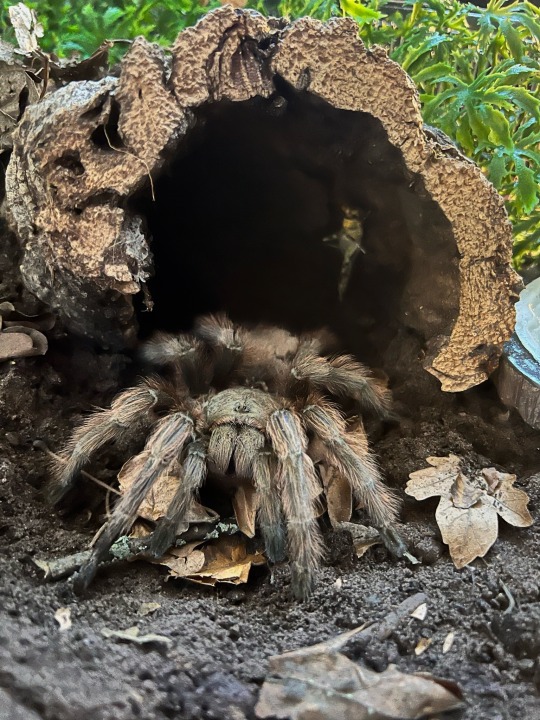
Vault Tec got put into her forever house today! 🎉 she’s doing really well since we brought her back, and we’ve got fingers crossed her next moult will get rid of the nastiness from her last home, cause she’s scraggly af right now 😂
[id: Vault Tec, the brown Giant Brazilian Blonde tarantula, sat under her cork log in her enclosure]
39 notes
·
View notes
Text
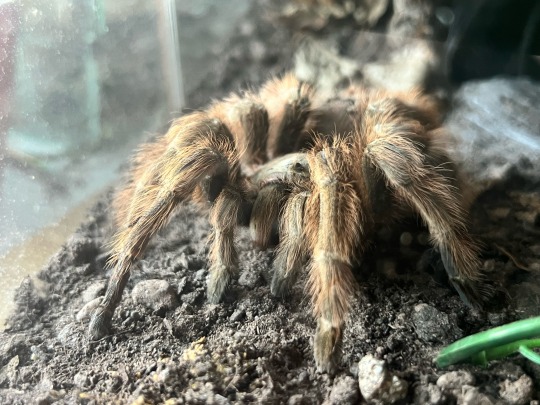
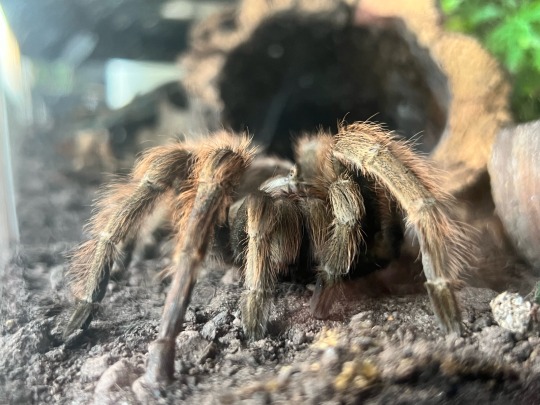
Vault Tec has started looking a little less scraggly now she’s being properly taken care of, I can’t wait til she has her next moult and gets the last bits off her little butt, partly because she’ll hopefully stop being as grouchy then 😂
[id: Vault Tec, the brown and black Brazilian Giant Blonde tarantula (nhandu tripeppii) in her enclosure with her cork tube behind her]
77 notes
·
View notes
Photo
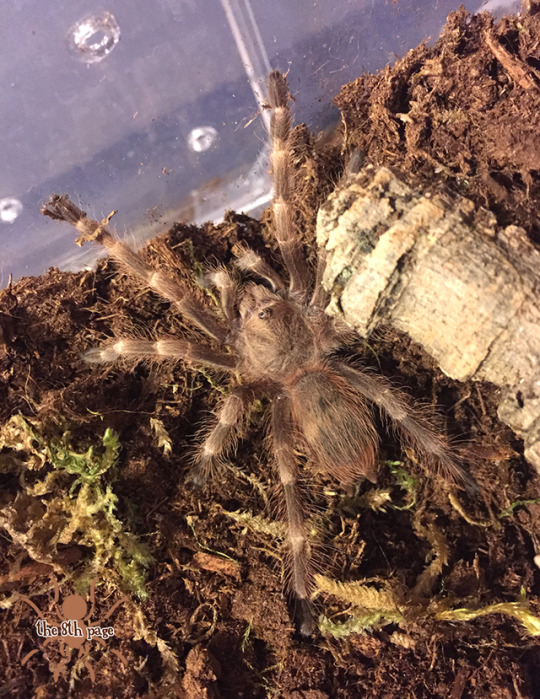
Nhandu tripepii | Brazilian Giant Blonde (unsexed juvenile, 2.5″)
See more photos of this species here!
14 notes
·
View notes
Photo
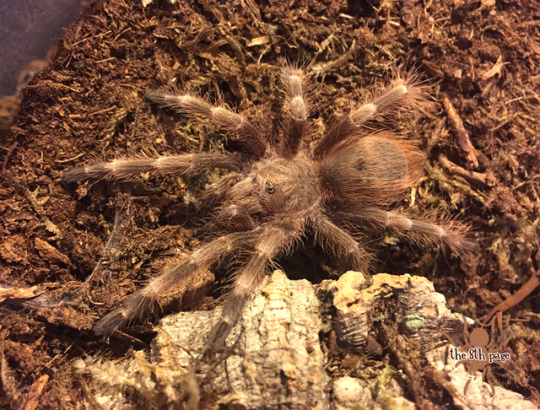
Nhandu tripepii | Brazilian Giant Blonde (unsexed juvenile, 2.5″)
See more photos of this species here!
8 notes
·
View notes
Photo
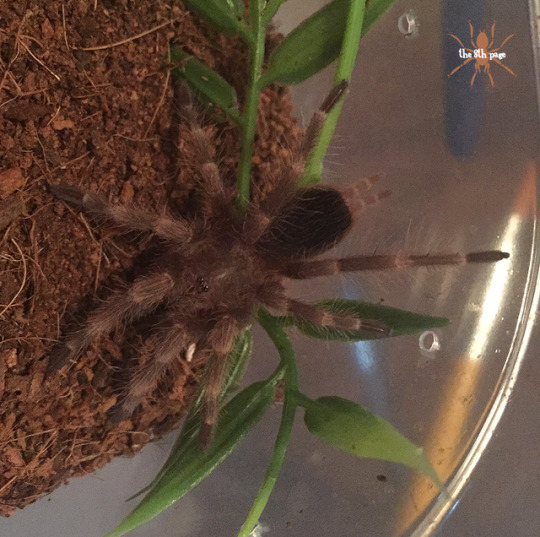
Nhandu tripepii | Brazilian Giant Blonde (unsexed spiderling, 1.5″)
See more photos of this species here!
20 notes
·
View notes
Text
TARANTULAS I HAVE:
acanthoscurria geniculata | brazilian white knee
aphonopelma anax | texas tan
aphonopelma seemani | stripe knee (SA/A)
avicularia avicularia | guyana pinktoe (SA/A)
avicularia metallica
brachypelma hamori | red knee (juvi)
bumba cabocla/bumba horrida | brazilian redhead
caribena versicolor | antilles pinktoe x2 (SA/A, sling)
davus pentaloris | guatemalan tiger rump
dolichothele diamantinensis | brazilian blue dwarf beauty (juvie)
grammastola iheringi | pampas tawny red
grammastola pulchra | brazilian black
grammastola pulchripes | chaco golden knee
grammastola rosea | chilean rose hair
hapalopus coloratus (juvie/SA)
hapalopus formosus | pumpkin patch
holothele longipes | dwarf pink/colombian blue leg x2
kochiana brunnipes | pink leg x2
lasiodora parahybana | salmon pink birdeater
neischnocolus sp panama/ami sp panama | gold banded sunburst dwarf
nhandu tripepii | brazilian blonde x2
pterinopelma sazimai | iridescent blue/sazimai's
tliltocatl albopilosus | nicaraguan curly hair (juvi)
tliltocatl kahlenbergi | new mexican (juvi)
tliltocatl sp 'Angustum'x2
tliltocatl vagans | mexican red rump
tliltocatl verdezi | mexican rose grey
ybyrapora diversipes | amazon sapphire pinktoe
TARANTULAS I WANT:
avicularia juruensis M2 | peru purple pinktoe
avicularia minatrix | red stripe pink toe
avicularia purpurea | purple pink toe
avicularia sp "Colombia" | silver pink toe
brachypelma baumgarteni | Michoacan orange beauty
brachypelma klaasi | mexican pink
chromatopelma cyaneopubescens | green bottle blue
citharacanthus cyaneus | cuban blue/orange-violet dwarf
cyriocosmus aueri | peru love heart
cyriocosmus elegans | trinidad dwarf/love heart butt
cyriocosmus leetzi | colombian dwarf
cyriocosmus perezmilesi | bolivian dwarf beauty
homoeomma sp blue peru/euathlus pulchermiinkaklaasi
neischnocolus sp chica | mini mesmo
tliltocatl schroederi | mexican black velvet
TARANTULAS I WANT BUT I'M TOO CHICKEN TO TRY:
neoholothele incei gold | trinidad olive gold form
neoholothele incei | trinidad olive
pseudohapalopus kurzhaar
pseudhapalopus sp blue | colombian blue botty
thrixiopelma pruriens | peruvian green velvet
TARANTULAS I HAVE HAD BUT LOST:
aphonopelma hentzi | texas brown
aphonopelma seemani | white stripe knee
avicularia purpurea
cardiopelma sp mascatum/sp "oaxaca" | dwarf bicolour
hapalopus sp "Guerilla"
neostenotarsus sp suriname | Suriname dwarf
pseudoclamoris gigas | orange tree spider
MISCELLANEOUS:
Assbolus verrucosus | blue death feigning beetles x3
Hierodula majuscula | Giant Australian Mantis
Phidippus regius "Isla Juventus" | jumping spider "Isla Juventus"
MISC WANTED:
fufius sp 'Rurrenabaque' | gold wafer-lid trapdoor spider
carausius morosus | indian stick insects
miomantis paykulii | egyptian praying mantis
phyllocrania paradoxa | ghost mantis
therea olegrandjeani | question mark cockroach
chlorocala oertzeni | purple flower beetle
chlorocala umtaliensis | opal flower beetle
cyclommatus metallifer | 'amethyst' metallic stag beetle
lamprima adolphinae | 'galaxy' or plain jewel stag beetle
mecynorrhina ugandensis | 'pure blue' giant flower beetle
phalacrognathus muelleri | 'emerald' or 'ruby' or plain rainbow stag beetle
protaetia aeruginosa | jewel flower beetle
protaetia cyanochlora | sapphire flower beetle
protaetia jousselini | turkish flower beetle
2 notes
·
View notes